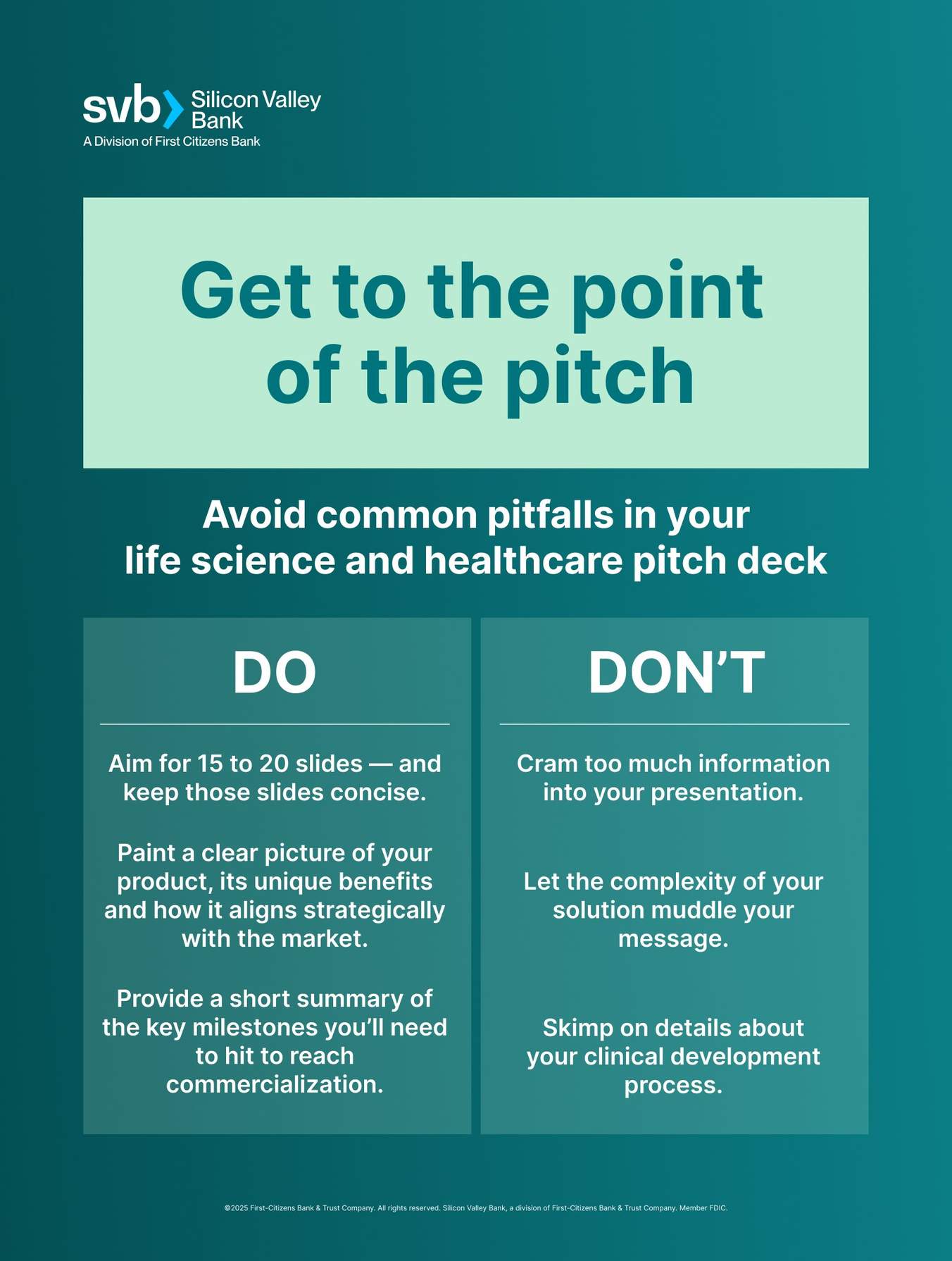- Life science and healthcare pitch decks differ from tech sector pitches in specific ways, but there are fewer resources to help life science entrepreneurs.
- When pitching investors, founders need to build a case that adequately addresses the long clinical timelines and increased risk that investors bear with a compelling storyline that leads to a winning exit.
- The best pitch decks explain the technology and problem it solves, the clinical development timeline, market sizing and opportunity, as well as the key luminaries who support the company.
The best pitch decks build a compelling business case through a clear narrative
It’s challenging to create a convincing pitch that succinctly summarizes the business value of an inherently complex bioscience or technology-based solution. But if you’re a life science and healthcare entrepreneur, it’s critical to have a sharp pitch deck that lays out the problem you’re solving, the size of the market you’re addressing and whether your team has charted a viable road map to success with a clear exit.
As an entrepreneur, you may have a good idea in general terms about what investors look for when evaluating startups. But if investors can clearly understand what you’re trying to do and how your efforts fit into current funding trends, your odds of success are likely to improve greatly. For example, SVB’s proprietary research shows that artificial intelligence (AI) tools are driving investments across the healthcare space — particularly in the biotech sector, which invested $5.6B in AI technology in 2024.
Resources and examples
Plenty of online resources outline the common elements required for all types of pitch decks regardless of industry — such as a company overview, the corporate mission, a section outlining how to effectively size the market, an overview of the competition and key stakeholders, along with the technical details of your solution and expertise of your team. When they attempt to organize all that information into a compelling deck, however, many entrepreneurs run into common pitfalls:
- Taking too long to get to the point. You should tell your story in a way that hooks readers right on page 1.
- Telling a story that’s too long. A pitch deck should produce a smart, concise narrative (ideally no more than 15 to 20 slides).
- Cramming too much information on each slide. Your live presentation should be more than a recitation of what’s in the deck.
To make things more challenging, first-time life science and healthcare entrepreneurs tend to have fewer industry-specific resources that can help them create clear, compelling and concise pitch decks than founders in other technology sectors.

What’s more, life science and healthcare pitch decks need to account for specific industry-focused nuances as well as the extended time frame it takes before many of these ventures realize revenue. The clinical development pathway is particularly important for life science entrepreneurs to address. It provides critical information about how much money you must raise to get to market, as well as the types of investors you need to secure so that you don’t wind up completely tapped out of capital before the process concludes. We’ve gathered a few examples of specific elements to consider as life science and healthcare entrepreneurs sharpen their pitch decks.
Key tips for a winning pitch deck
Because life science and healthcare investors take on more risk over a longer period of time, your goal is to demonstrate how your lead asset (for a therapeutics company) or your device/diagnostic is strategically aligned with the market and that there is a good chance to commercialize it successfully.
There may be some differences among investor audiences that specialize in specific subsectors, but in my experience, the most successful pitch decks tailored for life science and healthcare investors do these six things well:
1. Impart a clear understanding of the lead asset or product and the target market. The goal is to make sure the reader clearly sees what you intend to pursue. It may sound simple as a concept, but the more complex your technology, the more difficult it can be to pull this off. Paint a clear picture of your lead pipeline/product, its unique benefits and how it is strategically aligned with the market. SVB’s life science and healthcare sector reports, like our Healthcare Investments and Exits reports, are a useful source of market trend information that can help inform these time-sensitive aspects of your presentation.
2. Articulate the clinical development timeline — on one slide. In life sciences, everything is framed in the context of navigating the choppy waters of the clinical development timeline to the point where your lead asset becomes commercially viable. Your pitch deck needs to include a slide that clearly communicates key junctures so investors can make an informed investment in your company. Your timeline should include important pre-clinical and clinical development milestones as well as the costs to achieve them. Clearly highlight both operational as well as research and development (R&D) costs. Be sure you also include information about any additional assets within your pipeline, including the timeline for development of each. The goal is to document as clearly as possible how much funding and time you need to build the business.
3. Demonstrate the relationship between market size and investment capital. In lay terms, these are the critical details of what’s required to get the product to market as well as a demonstration of the project’s ultimate viability. The questions that you should answer here include:
-
- Does the asset have a viable commercialization play?
- Are you addressing a market with a high unmet medical need coupled with a large market size?
- Are you showing figures framed in the following context?
- Total addressable market (TAM) is the total possible users of the solution you are proposing.
- Serviceable addressable market (SAM) refers to the realistic number of customers that can be reached in terms of market access, regulation and other logistics.
- Serviceable obtainable market (SOM) is the specific customer universe that the company can reasonably serve under its current strategy.
Each of these are concentrically smaller subsets of the same market. It is important to look at the SAM/SOM as key areas of initial commercialization focus. Deep intelligence and market data is crucial and can help you make a better case that shows a clearer path to a successful exit for potential investors.
4. Show the propensity to adopt. Demonstrate the likelihood clinicians and patients will use your product when it reaches the market, as well as the likelihood of it becoming a widely used standard of care across the industry. Provide information about the path to insurance reimbursement. What does your approval pathway look like? For example, is your tech de novo or are there previous clinical trials you can leverage to achieve approval faster?
5. List key industry luminaries on your team who can advocate for your solution. It is an open secret that opinion leader advocacy is extremely important when making a case with investors in life science and healthcare. Many investors look at the advisory boards of companies knowing that they can help entrepreneurs make mission-critical network connections that often translate into competitive advantages such as access to clinical trials in the best medical centers.
6. Highlight the company’s IP. Be explicit about the IP assets your enterprise possesses. Explain the relative strengths they afford your company and your ability to defend your position.
These six interrelated elements will help differentiate your pitch deck from your competition, as well as those in other industries. Including them will help sharpen your story and build a compelling case attuned to your potential investors’ needs, which in turn can improve your odds of successful fundraising.
FAQs
What should be included in a life science and healthcare pitch deck?
You’ll want to include a succinct summary of the problem you’re solving, the market you’re addressing, clinical trial planning and your road map to success.
How are life science and healthcare pitch decks different from other industries?
They must take into account the specific nuances of key industry subsectors, as well as the extended time it can take to navigate clinical development and realize revenue.
How do you address market sizing in biotech?
Frame figures in the context of your total addressable market, serviceable addressable market and serviceable obtainable market to help clarify the path toward a successful exit for potential investors. These figures can include specific disease population statistics and the availability of other existing drugs/devices for treatment.
Why is the clinical development timeline critical?
It serves as a road map of key milestones on your way to commercial viability — and the funding you’ll require along the way.
How should IP be presented to investors?
Talk about IP assets in the context of the competitive strength they afford your enterprise, as well as how they help defend your market position.

